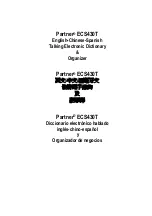
Program P4: String 4-6: Damping and Dispersion
253
4-6b: Dispersion
Dispersion
[0…100.0]
This models the rigidity of the string. Higher values
correspond to thicker-gauge strings, and increase the
inharmonicity of the string. (“Inharmonicity” means
that the pitches of the overtones become out of tune
with the fundamental.) At extreme values, it will create
bell-like timbres, as if you were hitting a bar of metal.
Dispersion
can be modulated by three AMS sources,
which are added to the Dispersion setting.
Character
[Bell, String]
This changes the way that the upper harmonics
become detuned as
Dispersion
is increased.
With the
Bell
setting, as you increase the
Dispersion
amount, the lower harmonics will go out of tune
gradually, but the upper harmonics will do so very
steeply. The higher the harmonic, the more out-of-tune
it will become. The resulting inharmonicity is similar
to the sound of a bell.
With the
String
setting, the upper harmonics will still
become more out of tune than the lower harmonics,
but with a more gradual slope. Up to moderately high
Dispersion
settings, this retains a string-like character.
AMS 1
[List of AMS Sources]
This selects the first modulation source to control the
Dispersion
. For a list of AMS sources, see “AMS
(Alternate Modulation Source) List” on page 967.
Intensity
[-100.0…+100.0]
This controls the depth and direction of the
Dispersion
AMS modulation.
Intensity Mod AMS
[List of AMS Sources]
This selects an AMS source to modulate the intensity of
AMS 1
.
Intensity
[-100.0…+100.0]
This controls the depth and direction of the
Intensity
Mod AMS
.
AMS 2
[List of AMS Sources]
This selects a second modulation source to control the
Dispersion
. For a list of AMS sources, see “AMS
(Alternate Modulation Source) List” on page 967.
Intensity
[-100.0…+100.0]
This controls the depth and direction of
AMS 2
.
AMS 3
[List of AMS Sources]
This selects a third modulation source to control the
Dispersion
. For a list of AMS sources, see “AMS
(Alternate Modulation Source) List” on page 967.
Intensity
[-100.0…+100.0]
This controls the depth and direction of
AMS 3
.
String Track
String Track Intensity
[–100.0…+100.0]
This controls the overall depth and direction of
String
Track’s
effect on
Dispersion
. You can adjust the offsets
for each individual string using the
String 1...6
parameters, as described below.
String 1...6
[–100…+100]
These set the individual
Dispersion
offsets for the six
Strings, as set under “9-9b: Strings” on page 277. For
instance, you might set the lower strings to greater
values, to model typical guitar strings.
These values are also available for modulating other
parameters via AMS; they appear in the AMS list as
Disp. String Track
.
▼
4–6: Page Menu Commands
The number before each command shows its ENTER +
number-key shortcut. For more information on these
shortcuts, see “ENTER + 0-9: shortcuts for menu
commands” on page 138.
• 0:
Write Program
. For more information, see “Write
• 1:
Exclusive Solo
. For more information, see
Содержание Electronic Keyboard
Страница 1: ...Parameter Guide Parameter Guide ...
Страница 2: ......
Страница 180: ...Program mode EXi 170 ...
Страница 290: ...EXi STR 1 Plucked String 280 ...
Страница 572: ...Sequencer mode 562 ...
Страница 700: ...Global mode 690 ...
Страница 751: ...Insert Effects IFX1 IFX12 Routing 741 Fig 2 3a Fig 2 3b ...
Страница 902: ...Effect Guide 892 ...
















































